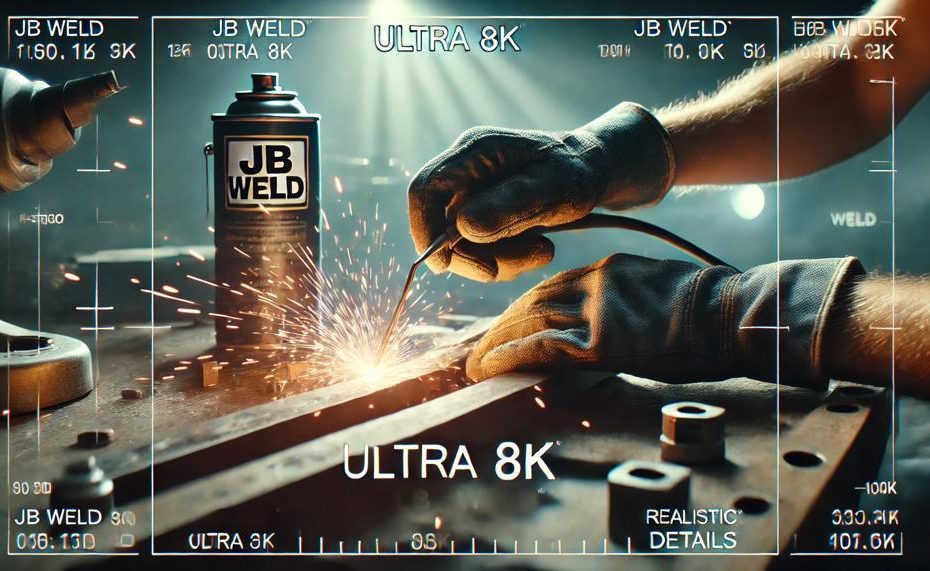Welcome to the fascinating world of DIY repairs, where the legendary JB Weld often plays a starring role. Whether you’re a seasoned handyman or just starting to explore the realm of home repairs, understanding the nuances of using JB Weld can be a game-changer. This wonder adhesive, known for its incredible strength and versatility, is a go-to solution for bonding metal, ceramics, wood, and many other materials.
But what happens when you’re faced with a repair over an existing JB Weld application? Is layering JB Weld on JB Weld the DIY equivalent of a double-down bet in blackjack, or is it a viable strategy for even stronger bonds?
In this article, we’ll delve into the nitty-gritty of applying JB Weld over an existing layer, providing you with a comprehensive guide to when and how this approach can be beneficial.
Whether you’re dealing with a minor crack or a major break, understanding the intricacies of this technique can significantly impact the durability and effectiveness of your repairs.
Key takeaways include:
- A clear explanation of what JB Weld is and its typical applications.
- Insightful analysis on the advisability of applying JB Weld over an existing layer, including the scenarios where this method shines.
- Practical tips to ensure your JB Weld on JB Weld application is as robust and enduring as possible.
Join us as we explore this intriguing topic, offering you the knowledge and confidence to tackle your next repair project with ease.
Contents
- 1 Can You Put Jb Weld Over Jb Weld?
- 2 Understanding the Strength and Durability of JB Weld
- 3 Can You Put JB Weld Over JB Weld?
- 4 Factors to Consider Before Adding Another Layer
- 5 Proper Preparation for Applying Multiple Layers of JB Weld
- 6 The Importance of Following Instructions and Safety Measures
- 7 Does Adding Multiple Layers Make the Weld Stronger?
- 8 Conclusion
Can You Put Jb Weld Over Jb Weld?
Yes, applying JB Weld over an existing JB Weld layer is possible, but it demands careful attention to detail to ensure the repair’s integrity. The steps and considerations outlined below are essential for a successful outcome.
| Step/Consideration | Details | Why It Matters |
| Clean the surface | Use a degreaser or rubbing alcohol, then wipe with a cloth. | Ensures strong adhesion by removing any contaminants. |
| Check curing | Ensure the previous JB Weld has fully cured; if not, sand it down. | Partially cured layers can compromise the new bond’s strength. |
| Mix accurately | Follow the manufacturer’s instructions for mixing resin and hardener. | Improper mixing can result in a weak bond or incomplete curing. |
| Roughen the surface | Use sandpaper to create a texture on the existing JB Weld. | Improves mechanical adhesion for the new application. |
| Apply in thin layers | Thick layers cure poorly and may not bond well. | Ensures even curing and optimal bonding strength. |
| Curing time | Allow at least 24 hours for curing before use. | Fully cured adhesive provides maximum strength and durability. |
Remember, patience and precision are key when working with JB Weld, especially when layering it over an existing application. Each step, from cleaning to curing, plays a critical role in achieving a bond that’s not just strong, but also lasting.
Understanding the Strength and Durability of JB Weld
Understanding the Strength and Durability of JB Weld hinges on several key factors that contribute to its remarkable effectiveness as a welding solution. These elements include its unique formula, the addition of steel particles, and the critical curing process. Each plays a pivotal role in ensuring JB Weld delivers a strong, durable bond capable of withstanding harsh conditions.
Key Contributors to JB Weld’s Strength and Durability
- Unique Formula: At its core, JB Weld’s strength comes from its bespoke two-part epoxy compound. This concoction is designed to create a steadfast chemical bond that laughs in the face of heat, pressure, and vibrations, making it an ally in repairs that demand longevity.
- Steel Particles: It’s not just any bond; it’s reinforced. The inclusion of fine steel particles escalates its strength, allowing it to embrace high temperatures without a whimper. This metallic blend is why JB Weld can stand its ground when the heat is on.
- Curing Process: The alchemy of turning liquid to a solid bond that can rival the strength of metal lies in its curing process. A symphony of heat and pressure during this phase ensures the bond matures into a form that’s both resilient and enduring.
- Versatility: JB Weld doesn’t shy away from a challenge, be it metal, wood, plastic, or ceramics. This adaptability makes it a go-to for a wide range of materials, amplifying its utility in the welding world.
- Surface Preparation and Application Techniques: Like a painter with a canvas, the effectiveness of JB Weld hinges on the prep work and application finesse. Proper surface cleaning, roughening, and precise mixing are the brush strokes that lead to a masterpiece of durability.
Impact on Effectiveness
| Factor | Contribution | Effectiveness |
| Unique Formula | Chemical bond formation | Resists heat, pressure, vibrations |
| Steel Particles | Strength enhancement | High-temperature resilience |
| Curing Process | Strength and durability increase | Long-lasting, reliable bond |
| Versatility | Applicable to various materials | Broad usability |
| Surface Preparation | Ensures bond integrity | Maximises bond strength |
In essence, JB Weld’s effectiveness as a welding solution isn’t a stroke of luck but a result of its well-thought-out composition and application methodology.
Can You Put JB Weld Over JB Weld?
Yes, you can apply a second layer of JB Weld over an existing layer, provided you adhere to certain guidelines to ensure the bond remains robust and effective. Here’s a structured approach to doing it right:
Preparation and Considerations
Before adding a new layer, it’s crucial to assess the surface and existing JB Weld layer. The table below outlines the key steps for preparation:
| Step | Action | Details |
| 1 | Surface Type Check | Confirm the surface is non-porous, like metal, for optimal adhesion. |
| 2 | Existing Layer Assessment | Ensure the first JB Weld layer is fully cured and undamaged. |
| 3 | Surface Cleaning | Clean off any dirt, grease, or rust to ensure a clean bonding surface. |
Applying the Second Layer
After ensuring the initial layer and surface are ready, follow these steps for application:
- Mixing: Stir the JB Weld components thoroughly as per the instructions to guarantee a strong mix.
- Application: Gently apply the second layer over the first, ensuring all gaps or cracks are well covered.
- Curing: Allow ample time for the second layer to cure fully, referring to the product instructions for specifics related to temperature and humidity.
- Support: Utilize clamps or supports to keep the repair steady and aligned during the curing phase to avoid any displacement that might weaken the bond.
Factors to Consider Before Adding Another Layer
Before delving into a fresh layer of JB Weld, there are crucial aspects to weigh up. Here’s a straightforward guide:
| Factor | Description | Key Point |
|---|---|---|
| Purpose and Strength | Why add it? How’s the first layer? | Assess and justify |
| Compatibility and Bonding | Do layers mesh well? Right conditions? | Compatibility and environment |
| Surface Prep | Clean and abrade | Prepare for success |
| Application Technique | Use proper tools, don’t rush | Precision matters |
| Thickness and Curing | Avoid too thick, let it cure | Patience and caution |
| Testing and Safety | Test small, follow safety | Test and protect |
Remember, it’s not just slapping on another layer; it’s about adding it with purpose and care.
Proper Preparation for Applying Multiple Layers of JB Weld
To ensure the utmost success when applying multiple layers of JB Weld, a meticulous preparation process is paramount. This preparation involves a series of steps that guarantee a sturdy, enduring bond between the surfaces in question. Below, find the key stages distilled into a clear, actionable guide.
| Step | Action | Reason |
| Clean Surfaces | Eliminate all grime, grease, and rust from the surfaces. | Ensures the JB Weld adheres firmly without interference from contaminants. |
| Roughen Surfaces | Use sandpaper or a wire brush for texturizing the bonding areas. | Increases the surface area for the JB Weld to grip onto, enhancing the bond strength. |
| Mix JB Weld | Combine the JB Weld components precisely as per the guidelines. | A well-mixed compound ensures consistent bonding properties across all layers. |
| Apply First Layer | Spread a thin, even layer of JB Weld on one of the prepared surfaces. | Acts as a foundation, anchoring the subsequent layers with a solid base. |
| Join and Clamp | Press the pieces together firmly, securing them for a minimum of 15 minutes. | Facilitates the initial bond formation between the surfaces and the JB Weld. |
| Curing | Allow the first layer to dry thoroughly before adding more layers. | Prevents the mixture from becoming too thick or uneven, which could weaken the bond. |
| Sanding | Once fully cured, sand any excess or rough edges for a smooth finish. | Creates a neat appearance and prepares the surface for additional layers, if needed. |
| Follow Curing Instructions | Adhere to the specific curing time and temperature for optimal results. | Ensures the JB Weld reaches its maximum bonding strength and durability. |
Remember, each step is critical to the overall success of the bonding process. Skipping a phase or hurrying through the procedures could compromise the integrity of the bond. Always give the JB Weld ample time to cure between layers and before putting the bonded items to use.
The Importance of Following Instructions and Safety Measures
The essence of heedfully adhering to guidelines and safeguarding protocols while handling JB Weld lies not only in ensuring a robust and durable bond but also in safeguarding one’s well-being and that of others around. This adhesive, known for its mighty bonding capabilities, demands respect for its composition and the potential risks if mishandled.
Below is a dive into the pivotal reasons underpinning this adherence, echoing not just the practicality of its application but also embedding a culture of safety and excellence.
| Aspect | Reason for Importance | Outcome |
| Safety | Prevent chemical exposure and injuries | Health preservation |
| Effectiveness | Proper application and bond strength | Successful repairs |
| Waste Reduction | Efficient use of material | Cost and resource saving |
| Repair Longevity | Durable and reliable fixes | Time and effort saving in the long run |

In essence, the act of meticulously following instructions and adhering to safety measures while using JB Weld is not merely about achieving a strong bond; it’s about embedding a practice of precision, safety, and respect for the material and its application.
Does Adding Multiple Layers Make the Weld Stronger?
Adding multiple layers of JB Weld doesn’t notably enhance the strength of a weld. It’s a bit like adding extra coats of paint on a wall; the first coat does the main job, and more layers might just be for show or minor improvements. Let’s break it down with a focus on JB Weld, a popular two-part epoxy.
Versatility in a Tube
Two-part epoxies, like JB Weld, are the unsung heroes of the toolbox. Known for their robustness and reliability, these adhesives are a go-to for bonding metal, sealing leaks, and even filling cracks with aplomb. Yet, when it comes to layering them up, the game changes a tad.
Prevention Better Than Cure
Before diving into the layers, it’s wise to store your epoxy in a ziploc bag.
It’s a simple trick to keep your tools clean and the epoxy ready for action.
The Contenders
Brands such as Gorilla, Devcon, Loctite, and JB Weld dominate the market, each with its unique formula. Despite the array of options, JB Weld has cemented its reputation for strength and durability.
Strength in Numbers?
The true test of epoxy lies in its ability to hold weight and resist torque. Original JB Weld and Devcon Plastic Steel have shown exceptional performance, outshining their newer counterparts and even some quick-set epoxies.
| Epoxy Brand | Weight Support | Torque Resistance |
| Original JB Weld | Excellent | Excellent |
| Devcon Plastic Steel | Excellent | Excellent |
| Newer JB Weld | Good | Good |
Layer Upon Layer
The crux of the matter is whether adding more layers of JB Weld makes the bond stronger. Despite assumptions, layering doesn’t significantly increase strength.
The initial layer of JB Weld establishes the primary bond, and while additional layers might offer marginal improvements, they do not drastically alter the weld’s overall strength. This insight emphasizes the importance of applying the right amount the first time around.
Safety First
Regardless of how many layers you’re considering, remember the importance of safety and proper application techniques. Ensuring a strong, durable bond while avoiding harm is paramount.
So, when it comes to making repairs or crafting bonds with JB Weld, think quality over quantity.
Conclusion
In the realm of DIY repairs, the versatility and strength of JB Weld have become almost mythical, a beacon for those seeking durable solutions for bonding materials ranging from metal to ceramics.
The exploration into the application of JB Weld over an existing JB Weld layer sheds light on a nuanced technique, akin to mastering a higher level of craftsmanship in the art of repair. This article has meticulously demystified the process, guiding us through the crucial steps and considerations for reinforcing repairs with an additional layer of JB Weld.
From the importance of surface preparation to the patience required during curing, the journey toward achieving a bond that rivals the original’s strength is marked by precision and a deep understanding of JB Weld’s chemistry. The insights provided extend beyond mere instruction; they encapsulate a philosophy of repair that emphasizes respect for materials, meticulous preparation, and an appreciation for the craft of bonding.
Whether seeking to mend a minor crack or fortify a major break, the wisdom distilled here serves not only to enhance the durability of repairs but also to elevate the skillset of the DIY enthusiast.





